#Volvo Electric Car to Be Priced against Tesla Model 3 and C
Explore tagged Tumblr posts
Text
Volvo Electric Car to Be Priced against Tesla Model 3 and Chevrolet Bolt EV
–
Volvo’s electric car, expected in 2019, could prove a formidable rival to the Tesla Model 3 and the Chevrolet Bolt EV as well as top-trim versions of the next-generation Nissan Leaf and several other longer-range EVs that are due out around that time. That’s because Volvo Car USA CEO Lex Kerssemakers recently revealed one eye-opening target for the project: a base price between $35,000 and $40,000.
–
Like the Model 3 and the Bolt, Volvo’s as yet unnamed electric model is expected to offer a range of 250 miles or more. Although there are a few automakers that think electric cars don’t need to go for maximum range—Honda, for instance—the consensus within the industry is that range sells.
–
Premium badges add appeal, too, and Volvo’s plan illustrates the different ways in which luxury brands plan to jump into the EV market. The Jaguar I-Pace, for instance, is expected to play in Tesla Model X territory, with a starting price well over $60,000. At $40,000, Volvo, on the other hand, would be offering a premium-badged electric vehicle for roughly the same price as some mainstream-brand models.
–
Volvo’s lowest-priced U.S. model at present is the S60 sedan, at $34,945, although the new EV plus the return of the smaller 40-series vehicles, anticipated to start arriving late next year, will give the automaker a smorgasbord of entries in the $30,000-to-$40,000 range.
–
–
The EV is likely to share some elements with Volvo’s Compact Modular Architecture (CMA) platform, which will underpin its 40-series compact vehicles, but it will use its own set of modular electrification underpinnings. Last May, Volvo showed two electric-vehicle design concepts: the 40.1 crossover and the 40.2 sedan, previewing the design direction for the XC40 and the S40, respectively. At that time, Volvo said that there will be an electric vehicle based on the S40 or a unique vehicle derived from it.
–
–
Swede Plan, Bro: Volvo Plans New Compact Crossover and Sedan, Luxe 90-Series Models
–
Volvo Details New Small-Car Platform, Electrification Plans
–
Instrumented Test: 2016 Volvo XC90 T8 Twin-Engine AWD Plug-In Hybrid
–
–
In 2019, at around the same time the EV reaches the market, Volvo is also expected to introduce more hybrids to the product mix—including front-wheel-drive hybrid versions of its 40-series vehicles featuring an electric motor integrated with a dual-clutch automatic gearbox. Currently, the only Volvo hybrids—plug-in hybrids, actually—are the top all-wheel-drive T8 versions of the XC90, with a hybrid S90 coming soon.
–
from remotecar http://feedproxy.google.com/~r/caranddriver/blog/~3/T81qbznIuNY/
via WordPress https://robertvasquez123.wordpress.com/2017/03/20/volvo-electric-car-to-be-priced-against-tesla-model-3-and-chevrolet-bolt-ev/
0 notes
Photo

6 Automakers From China and Elsewhere That Surprised in Frankfurt
Auto shows are all struggling to reinvent themselves as more and more brands are choosing to sit them out. There were many no-show brands at this year’s Frankfurt show. Some shows are mounting concurrent “mobility” conferences, but Frankfurt seems to have added a supplier/engineering event such as North America’s SAE World Congress. Of course, prime show floor space vacated by Fiat, Alfa Romeo, Jeep, Nissan, Infiniti, Peugeot, and DS managed to get snapped up by “young Asian brands” with unfamiliar names such as WEY, Thunder Power, Aspark, and a few more-established names. We’ve got highlights. Borgward Isabella Concept This storied and supposedly still well-known and respected German brand has been revived by a team of Chinese investors. A plant is already up and running in China producing SUVs. The plan is to bring them to Europe next year and to eventually open a plant near Bremen, Germany, to build vehicles for European consumption. This fetching concept named for the fetching coupe produced in the brand’s heyday was penned by a new design team based in Stuttgart with designers plucked from Mini (Anders Warming) and Kia (David Genot). The Isabella borrows very few design cues directly from the vintage car, but it attempts to deliver what that car represented in its day—a beautiful accessible dream car. The four-door coupe profile features an exceptionally aerodynamic profile (air flows behind the C-pillars), and its interior is highly imaginative. Features include a “coffee table” lower shelf under a “surfboard” covered in silver mesh, bisected by a black “scarf,” which contains most of the controls for the large curved screen just below the windshield and also for a hologram display. These folks are dreaming big! Borgward BX5, BX7, and BXi7 Borgward is not part of a joint venture with any Chinese brands (there is a relationship with truck manufacturer Foton Motor Group), but boy, their styling department seems to be borrowing pretty heavily from Shanghai GM/SAIC’s work with Buick. The smaller BX5 and larger BX7 both seem to echo the waterfall grille and rear-quarter-panel details of the Buick. The BXi7 is an all-electric version of the BX7. The mainstream utes are on sale in China now, and sales in Europe are expected to start next year. Aspark Owl Japanese EV upstart Aspark unveiled this low-slung and fairly fetching supercar that’s about the size of a Ford GT, claiming some pretty amazing numbers for it: 0-62 mph in 2.0 seconds. Yikes. Naturally it’s routing its power to all four wheels, but even with only 1,900 or so pounds to tug around, that’s asking a lot of the tires’ grip. It’s also impressive given the modest output claims of 429 hp and 563 lb-ft of torque. The range is claimed to be about 90 miles, and the top speed is 174 mph. We’d caution against holding your breath for this one, but if it can put down numbers like those, there will be a lot less laughing at the dorky name. Thunder Power Speaking of names that might not have been thoroughly focus grouped in English-speaking countries, Hong Kong-based Thunder Power is also planning to get into the EV business. Unlike Aspark and a few American EV startups we can think of, Thunder Power has a factory under construction in Guangzhou, China, that will reportedly be capable of producing 100,000 EVs per year. An R&D center will be located near Barcelona, Spain, and the company is planning to build an assembly plant there, too, for satisfying European demand. This is Thunder Power’s second appearance at the Frankfurt show. Last time it showed a concept of the sedan that appears this year in development-prototype camo. The focal point of this year’s display is a new SUV concept that was presented along with a naked aluminum chassis buck. The SUV points in the general design direction of a production variant that is sure to lose the pillarless coach door arrangement and probably the cross-car infotainment screen. The sedan is expected to go on sale next year, with the SUV following a year later. Pricing for the sedan has been reported starting in the mid-50s stretching to 100,000 euros—so, Tesla territory. The Milanese design work might not strike all eyes as more beautiful than a Tesla. WEY China’s Great Wall introduced the premium SUV sub-brand WEY this past April and has opened a technical office in Germany. For its Frankfurt debut, it designed an off-road coupe concept called the XEV, which, as the name suggests, is electrically powered. The concept manages to look pretty good without looking like anybody else’s SUV—a rare combination in the still fairly nascent Chinese auto industry. WEY aims to begin selling its SUVs in Europe in 2019, most likely opening with the Hi4-hybrid powered VV5, which definitely has a vaguely familiar look to it. The crossover will be available in sporty S and Hi4 powertrain variants. The latter consists of a 2.0-liter gasoline four-cylinder Great Wall engine fitted with a belt-alternator-starter good for 13 hp, spinning the front wheels through a seven-speed dual-clutch transmission. Out back there’s a 174-hp electric motor. The hybrid battery stores just 1.166 kW-hr of electricity. Chery The Chinese invasion of Europe really gets rolling in 2019 when Chery expects to bring its globally homologated Exeed TX SUV model here (the Tiggo 5X and Tiggo 7 sharing the floor space do not meet European standards). Hatchbacks and wagons will follow in the years to come, with all new vehicles being designed (for now in Shanghai under the direction of Canadian James Hope, who was recently hired away of GM Europe) to meet European safety and regulatory standards. To rev up Frankfurt showgoers, Chery brought along its low-slung, muscular Tiggo Coupe crossover concept. Planned for autonomous drive, like nearly every new show car, this one aims to lure in millenials with a steering wheel that folds and becomes a game controller during autopilot mode. A vibrating seat aims to provide a vivid 4-D gaming experience. Chery plans to heavily target young people who are less brand conscious. Geely Chinese megabrand Geely, owner of Volvo, purchased the London Taxi Company from receivers in 2013, and the resulting sub-brand LEVC is now rolling out its next-gen “London Cab” and hoping to extend sales throughout Europe (hence the presentation of the TX eCity cab in German taxi beige). They are being built near Coventry in the first new assembly plant to be built in England in 10 years. The range-extended electric vehicle can travel 80 miles on an electric charge, after which a Volvo 1.5-liter I-3 engine kicks in and extends the range to 400 miles. The rear compartment is taller and roomier than the current black cab, with seating for six (three in rear-facing jump seats). Wi-Fi connectivity and both USB and 12-volt charging sources are provided for passengers, and there’s a panoramic sunroof. Deliveries begin in October at a price of 55,000 British pounds ($72,600). The vehicle is not homologated for U.S. sale. The post 6 Automakers From China and Elsewhere That Surprised in Frankfurt appeared first on Motor Trend.
http://www.motortrend.com/news/6-automakers-from-china-and-elsewhere-that-surprised-in-frankfurt/
0 notes
Text
Why I bought Honda's plug-in hybrid mystery car
At Christmastime, in the noble tradition of proud parents everywhere, I unloaded — I mean, generously donated — my 2009 Honda Fit to my college-student son.
That gesture wasn’t pure, heart-warming nobility; I wanted a new car. Specifically, an electric car.
I don’t know if you’re aware of how juicy the deals are on these things. Obviously, the main reason you’d get one is because they’re much better for the environment. (Yes, they run on electricity, which still requires burning some fossil fuels to generate — but the impact of electric cars is drastically lower than gas cars.)
But even if you don’t care about being green, an EV (electric vehicle) still get you all of this:
A tax credit from the Federal government. That’s not a tax deduction, which lowers your income before you calculate the tax. It’s a tax credit, which is money in your pocket after taxes. Depending on the car’s electric range, it’s up to $7,500.
Money back from the state. Forty-five states currently offer juicy EV incentives, usually cash. I live in Connecticut, where it’s $2,000. Nothing to do with taxes — it’s just a check they send you.
You save tons of gas money. Electric-car owners never, ever pay for gas.
Special parking places. My Connecticut town is more progressive than most, but it’s got dedicated electric-car parking spaces at the grocery, library, train stations, town hall, and so on. They’re right next to the handicap spaces, and each one has a charging station. Free electricity while you’re shopping!
Drive alone in the carpool lane. Many states welcome EVs to the carpool (HOV) lane.
The brakes last, like, forever. When you brake, magnets capture your momentum and use it to recharge the battery, saving the brake pads.
They ZOOM! An electric car has incredible torque (translation: instant acceleration). They are fun!
They’re silent. There’s no engine noise, obviously. You hear only a faint hum/whine when you put the pedal down. Your music sounds that much better.
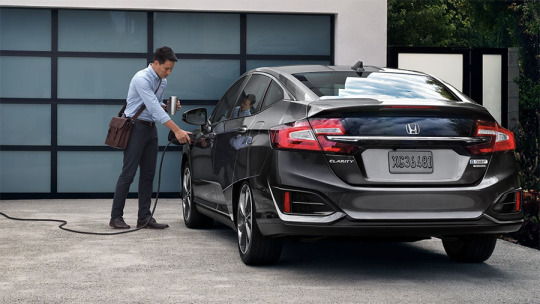
Owning a plug-in means remembering to plug in.
Of course, we all know why more people aren’t buying electric cars: range anxiety. Unless you’ve got something like a Tesla or a Chevy Volt (over 200 miles on a charge), you’re limited in the drives you can take. And it’s not like you can pull into a station and refuel in five minutes. You have to plan your life around charging stops: lunch, overnight stays. It’s a hassle.
But here’s the point of this article: There is a way to get all the advantages of electric without the range anxiety: plug-in hybrids. (Geeks call them PHEVs, for plug-in hybrid electric vehicles. Man, they really need a catchier name.)
A plug-in hybrid is electric with a gas-engine backup. Once the big battery’s dead, the car becomes a regular hybrid, like a Prius or whatever. Amazingly, the gods of legislation have determined that these cars are entitled to all the same goodies that pure electrics are.
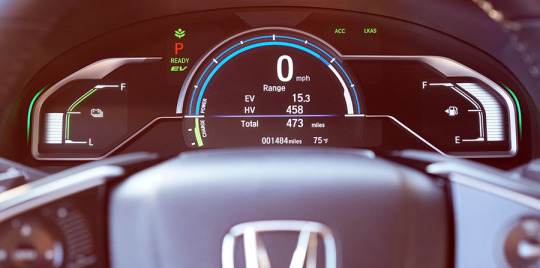
In a plug-in hybrid, you have two “fuel gauges” one each for battery charge (left) and gas level (right).
You can plug in one of these cars into a standard power outlet in your garage, as you would a lamp or something; it charges overnight. Or you can install a 240-volt outlet, like the one for a refrigerator; the car charges in a couple of hours. (Handily enough, public charging stations are 240V, too.)
There are lots of plug-in hybrid models. As a handy benefit, most of them are loaded with the latest autonomous safety features:
Lane keeping. If you start to drift out of the lane without your blinker on, the car warns you and guides you back into the lane.
Collision avoidance. If you’re coming too fast toward a slowing car ahead, the car warns you and actually brakes for you to avoid a collision.
Adaptive cruise control. You set a speed you want to maintain — let’s say 65 mph. At that point, the car speeds up and slows down (even stopping, if necessary) as necessary to avoid hitting the car in front of you. A button on the wheel controls how many car lengths you want your car to hang back.
Self-parking. Well, sort of: The car turns the wheel for you, but you still have to manage the shift lever and gas/brake pedals.
Here’s the journal of my quest to buy the perfect plug-in hybrid family car — and why we wound up buying an obscure, no-name Honda in the end.
Prius Prime
My wife and I started with a test drive at the local Toyota dealership. Our other car is a Prius, which we’ve always loved. (If the Tesla 3 I ordered two years ago ever shows up, we’ll sell the Prius.)
Anyway, we liked the looks of the Prius Prime, a plug-in hybrid. OK, we didn’t actually like the looks, but — you know.

The Prius Prime has a distinctive, polarizing look.
Here’s what we loved about this car:
The price. The base model is $27,100. The Federal tax credit is $4,500 for this model. With the Connecticut kick-in, my final price would be $20,600.
The hybrid MPG. You go 25 miles on pure electric; after that, the hybrid (gas-and-electric) mode gets an amazing 55 miles a gallon. Total range is 640 miles on one gas tank, which is extraordinary.
The wireless phone charger. If you have a recent iPhone or Samsung Galaxy, for example, you can just set it down in the center console — it instantly starts to charge, magnetically.

Why don’t all cars have Qi wireless phone charging pads built-in?
Cool smart stuff. Lane-departure warning, front-collision braking, and automatic high beams are all included in the base model.
The heads-up display. Just as on a fighter jet, the Prime can project important stats in space in front of the driver — your charge status, speed, current speed limit. It seems to hover a few feet in front of the windshield.
Here’s what we didn’t love:
It’s a four-seater. My wife and I have a blended family with, on and off, five kids. We’d really miss a fifth seat.
The trunk is the size of a subatomic particle. The batteries in this baby take up most of what would have been the trunk. We sometimes have to drive to our kids’ colleges in Massachusetts and Vermont, loaded up with stuff. That wasn’t gonna work.
25-mile electric range. That’s really not a lot. Would 25 miles cover your commute both ways? Remember that cold weather can cut your battery capacity in half.
All touchscreen. No volume knob at all. Auuugh! And no Apple CarPlay or Android Auto.
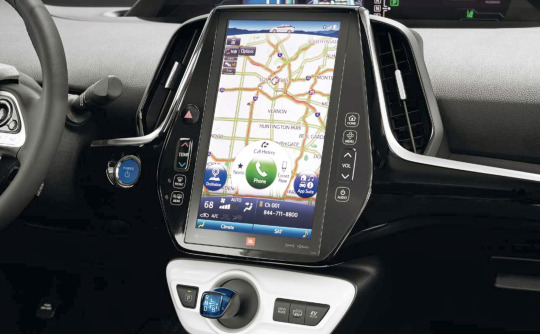
As on a Tesla, most of the Prius Prime’s controls have been moved to a touchscreen, meaning you have to take your eyes off the road to use them.
The ride. Man, this car hates rough pavement. It’s a bumpy ride. Also, as Car & Driver puts it, this is no sports car. “You buy this car to pass gas stations, not other vehicles.”
The good stuff costs. The heads-up display, phone charger, self-parking, and blind-spot monitor stuff are available only on the higher-end models, which erase a lot of the price advantage.
Chevy Volt
Man, if you want electric range (and you do), it’s hard to beat the Chevy Volt. This baby goes 53 miles on pure electric, more than any other PHEV. For a lot of people, especially commuters, that should cover it most of the time. (It’s easy to confuse this car with the Chevy Bolt, which is all electric — 238 miles of range, no gas hybrid mode.)
We took a test drive, and concluded that we loved these things about the 2018 Volt:
53-mile pure electric range. Of course, that also means it takes longer to charge fully: 13 hours on 120V, and 4.5 on 240V.
Super fun to drive. It’s a great ride.
It looks amazing. It’s a great-looking car.

The Chevy Volt looks awesome, even in a dealership parking lot in winter.
There’s also, unfortunately, quite a bit not to like:
It’s another four-seater. Chevy says it seats five, but that’s hilarious. You’d fit in the back middle seat only if you were a Barbie doll. Even the two actual rear seats are super-cramped; at 6 feet 2 inches, my head was mashed firmly against the roof.

The Chevy Volt’s back seat isn’t made for tall people.
It’s claustrophobic. Visibility is not good from the driver’s position.
It’s pricey. The base price is $34,100 — that’s $7,000 more than the Prius Prime. If you want the self-driving stuff (lane keeping, forward collision avoidance, self parking), the grand total is $40,000! Yeah, the tax credits and refunds will help, but… wow. This is a subcompact car.
The marketplace
We sat down that night to look at our other options. There’s a huge range of plug-in hybrids available; here’s a sample, showing base price and electric range. Notice anything in common with their all-electric ranges?
Audi A3 eTron: $37,900, 16 miles
BMW 330e: $44,100, 14 miles
Chrysler Pacifica (minivan!!): $42,000, 33 miles
Ford C-Max Energi SE: $27,120, 20 miles
Ford Fusion Energi: $31,100, 22 miles
Hyundai Sonata PHEV: $34,600, 27 miles
Hyundai Ioniq PHEV: $25,000, 29 miles
Kia Optima PHEV: $35,210, 29 miles
MiniCooper S E Countryman: $36,800, 18 miles
Volvo XC90 (SUV): $67,800, 14 miles
Those are puny ranges! What’s the point of a plug-in when you can drive only 9 miles in cold weather?
The Honda Clarity
In late December, we were just about to pull the trigger on the Chevy Volt when my wife suggested one final Google search. And incredibly, something popped up that I hadn’t seen before: Something called the Honda Clarity.
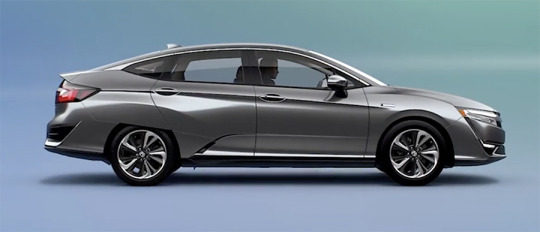
The Honda Clarity’s front half looks better than the back half.
It seemed to have everything we wanted: Room for five adults, full-sized trunk, all the cool autonomous features included in the base model, and 47 miles of electric range! That would make it the No. 2 longest-range plug-in hybrid on the market — and the only midsize, five-adult car with that kind of range.
I found that bizarre, and I still do. Why does the industry think nobody wants a family car with great electric range?
The weird thing is that this car was a total mystery. There was nothing about it online. No reviews —only a few blogger descriptions of a test-driving event Honda staged last fall. The local dealers didn’t know anything about it. There were no ads or marketing of any kind.
(Part of the confusion, no doubt, is that there are two other Honda Clarities: One’s pure electric, and one runs on hydrogen!)
We found a dealer an hour away with one Clarity in stock, and took it for a test drive. The car was an utter mystery to our salesman. He told us, for example, that the car is three feet longer than the Chevy Volt (it’s actually one foot longer), and that it takes 19 hours to charge (it actually takes 12, or 2.5 hours with a 240V outlet). He had no idea how to turn on the autonomous features. And the car hadn’t been charged, so we had to take our test drive on gas (42 mpg).
Here’s what we loved:
The ride. Maybe it’s because this is a midsize, and most of the others are compacts — but man, what a glorious ride. It floats like a magic carpet, except that you still have a great feeling of the road. And it’s soquiet on electric! Combine that with the zoomy acceleration from a stop (232 foot-pounds of torque, if you’re scoring at home), and you’ve got a really fun car to drive.
The space. Our kids have never known anything but compact cars. They could not believe the headroom and legroom when they climbed in.
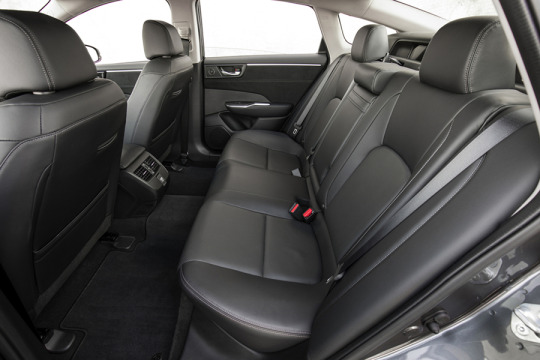
Nobody will complain of being crowded in the Honda’s back seat.
The trunk. It’s really big. But it’s weirdly shaped. It has a secondary sub-trunk, accessed with a trapdoor, and when the seats are folded down, the pass-through hole to the front is bizarrely shaped. But yeah — plenty of suitcases.

The Honda’s trunk is vast and deep, if weirdly shaped.
Adaptive cruise control. Unlike most cars with this feature, the Clarity’s adaptive cruise works even at low speeds, like in stop-and-go suburban traffic. It works really well. I use it a lot.
Blind-spot screen. When you turn on the right turn signal, the dashboard screen becomes a closed-circuit TV, showing you your right-side rear view. No more blind spot! (There’s nothing equivalent when you turn left, alas.)
Cup-holder cup holders. Each cup holder has two flip-out tabs to accommodate taller or narrower cups and bottles. A clever touch.

The Honda’s cup holders have flip-out tabs.
Auto-lock and unlock. The car unlocks itself as you approach (with the key fob on you), and can also auto-lock once you’re 15 feet away.
Phone pockets in the back. Such a little thing, but so great: A place to hold the back-seaters’ phones to get them out of the way.

A place to hold your phone while it’s charging.
Smart fob. You get two key fobs with the car, labeled Driver 1 and Driver 2. As you approach the car, it unlocks automatically, of course — but it also moves the driver’s seat into your preferred position and angle automatically, as memorized by your fob. (The fob should also adjust the rear-view and side mirrors, temperature, and radio stations for each driver, too. Well, someday.)

That wide button pops open the electric charging socket; the fan button warms up (or cools down) the car before you get in it.
Bio–plastics. The fabric surfaces inside are made of plants, not petroleum; on the high-end model, the dash is covered by suede, which looks and feels cool and is made of recycled material.
LED lights. All the lights — front, rear, turn signals — are LEDs, and they look awesome.

All the lights are LED and cool-looking.
All the goodies. So much stuff is included in the base model ($33,400)! Lane-keeping, front-collision auto-braking, adaptive cruise control. Apple CarPlay and Android Auto. An 8-inch touchscreen that’s not horrible. (There’s no volume knob, but a physical volume control is on the steering wheel.) Automatic high-beam dimming. Automatic rear-view-mirror dimming at night. Side-mirror heating, front-seat heating.

The Clarity’s drive shifter is electronic—buttons, not a shift stalk—which makes it clearer when you’re putting it in reverse.
The price. At $33,400, the Clarity is pricier than the Prius Prime ($27,100), but it definitely beats the much smaller Chevy Volt, comparably equipped ($40,000). The Clarity also earns the full $7,500 back from the government, plus, in my case, $2,000 back from the state of Connecticut. My final price would be $23,900.
The Touring model ($36,600) adds eight-way power-adjustable driver’s seat, leather seats, a built-in navigation system, and remote-control heating/cooling (you hit a button on the fob while you’re finishing breakfast).
We quickly found a few things we didn’t like, too:
It’s kind of ugly in back. The car looks great from the front, but the back end strikes us as weird/ugly. Some of that comes from aerodynamics: The back wheels are partly covered, for example; the bottom of the car is completely enclosed and flat; and funny little wind intake holes are tucked in the grille and in front of the rear wheel.
Lane assistance barely works. When the Clarity starts to creep out of the lane, it’s supposed to alert you (by vibrating the wheel and flashing a warning) and auto-steer gently back into the lane. It works amazingly well — when it works. But it doesn’t kick in until you’re going over 45 mph, and even then, it doesn’t seem to notice when it’s creeping over a yellow center line.
Occasional engine noise. When the gas has to kick in, it can be loud, and out of proportion to the accelerator position.
The paddles. Behind either side of the steering wheel, your fingers easily reach two paddles. They govern regenerative coasting, in four levels. That is, tug the left paddle four times, and your car reallyslows down during coasting (to recharge the battery more); tug the right one to lighten up. That setting resets to 0 when you next use the accelerator, though. Honda told me that “this feature can be especially useful as you drive downhill,” but using the brake also recharges the battery, so… why?
No self parking. Oh well.
No USB in back. There’s a cigarette-lighter charger in the back for the kids’ phones — but why on earth no USB jacks?
The name Clarity. My wife thinks it sounds like an antihistamine.
The biggest adjustment we had to make was accepting that the Clarity is a midsize car. Obviously, that’s why we get such great interior space, but it also means a wider turning radius and tighter parking. Mainly, my wife and I both grew up thinking that bigger cars equals worse bad fuel economy. It’s a mind-fuddler to realize that this is our green car!
So guess what? We bought it.

My first time parking the Clarity at an “EV CARS ONLY” spot!
Two months in
All of that happened the first week of January. I’m happy to report that some reviews for the Clarity are finally starting to appear online (spoiler: they like it too), and Honda Inc. is starting to do some marketing and dealer training, too. I guess we were just geniuses, buying this car before the world knew it was great.
The good news is that owning a plug-in hybrid is exactly what it’s cracked up to be: Super fun to drive, instant acceleration, and NO GAS STATIONS. We come home, we plug in the cable, we never use gas. We drive it every day, and we’ve refilled the gas tank once in two months (I had to drive to JFK airport in freezing weather).
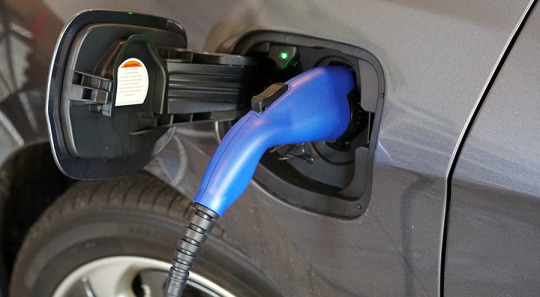
We charge the car from an ordinary 3-prong wall outlet on the garage.
The dealers I interviewed for the video above all say that consumers aren’t jumping on PHEVs the way you’d expect. It’s because people don’t know about plug-in hybrids, or don’t understand them, or don’t like change.
Well, if that’s you, change your mind; you’re crazy not to look into this category. Who doesn’t like saving money and getting a zippier car?
All three dealers also said I should have leased the car instead of buying it, because technology is moving along so quickly, this car will seem out of date in a few years. Of course, that’s what a dealer would say, right? But it’s something to consider.
Then again, if it gets to the point where I can’t stand having an ancient 2018 car, I won’t be stuck with it. I’ve got three more kids who will one day head off to college.
David Pogue, tech columnist for Yahoo Finance, welcomes non-toxic comments in the Comments below. On the Web, he’s davidpogue.com. On Twitter, he’s @pogue. On email, he’s [email protected]. You can sign up to get his stuff by email, here.
from laptop3 http://ift.tt/2sLLuDT read more heah aware
0 notes
Text
Ford's Electrification Push Includes Plug-In Escape and Lincoln Navigator Hybrid

-
Earlier this year, Ford announceda strong focusonhybrids, plug-in hybrids, and fully electric vehicles, with plans calling fora $4.5 billion investment to develop and produce 13 new electrified models by 2020.While two of those projects seem especially daunting-creating desirable hybrid versions of two icons, the F-150 and the Mustang-we've learned a little more about other vehicles that are part of this initiative.
-
For 2019, expect plug-in hybrid versions of the Ford Escape and the Lincoln MKC, along with hybrid versions of the Ford Expedition and the Lincoln Navigator. These new offerings are likely to give Ford's fleet fuel-economy average a healthy nudge upward.
-
As reported by Automotive News, citing sources with knowledge of Ford's product plans, all of these models are plannedand will be joined by the Mustang and F-150 hybrids in 2020.
-
The previousEscape hybrid was sold through the 2012 model year but was dropped in favor of the C-Max conventional hybrid and the C-Max Energi plug-in hybrid. Both Ford C-Max models are expected to be discontinued within the next year.
-

-
The other missing piece is an electric-only crossover, potentially called the Model E,which Ford plans to have in showrooms by 2020. Ford has already said that it's aiming to make the model affordable, meaning it would take onthe upcoming Tesla Model Y and all-electric crossovers from Volvo and Volkswagen, among others.
-
-
Ford's 300-Mile All-Electric Crossover: Affordability Is Job One?
-
Volvo Electric Car to Be Priced against Tesla Model 3 and Chevrolet Bolt EV
-
Electrified Icons: Ford Mustang and Ford F-150 Hybrids Coming by 2020
-
-
Ford also is in the midst of reassessing its global product plan and perhaps even increasingthe number of electrified projectsbeyond the already confirmed 13. Last week, the companyannounced that it has signed a memorandum of understanding to create a new joint venture with Anhui Zotye Automobile, a Chinese electric-vehicle maker and, according to Ford, one of the market leaders in all-electric small vehicles. It's exploring the possibility of setting up a new EV brand as well as a joint venture but hasn't yet begun either of those processes.
-
Will Ford become even more bullish on EVs? It should all become much clearer on October 3, when CEO Jim Hackett is expected to provide a strategic update to investors.
-

0 notes
Text
Ford’s Electrification Push Includes Plug-In Escape and Lincoln Navigator Hybrid
–
Earlier this year, Ford announced a strong focus on hybrids, plug-in hybrids, and fully electric vehicles, with plans calling for a $4.5 billion investment to develop and produce 13 new electrified models by 2020. While two of those projects seem especially daunting—creating desirable hybrid versions of two icons, the F-150 and the Mustang—we’ve learned a little more about other vehicles that are part of this initiative.
–
For 2019, expect plug-in hybrid versions of the Ford Escape and the Lincoln MKC, along with hybrid versions of the Ford Expedition and the Lincoln Navigator. These new offerings are likely to give Ford’s fleet fuel-economy average a healthy nudge upward.
–
As reported by Automotive News, citing “sources with knowledge of Ford’s product plans,” all of these models are planned and will be joined by the Mustang and F-150 hybrids in 2020.
–
The previous Escape hybrid was sold through the 2012 model year but was dropped in favor of the C-Max conventional hybrid and the C-Max Energi plug-in hybrid. Both Ford C-Max models are expected to be discontinued within the next year.
–
–
The other missing piece is an electric-only crossover, potentially called the Model E, which Ford plans to have in showrooms by 2020. Ford has already said that it’s aiming to make the model affordable, meaning it would take on the upcoming Tesla Model Y and all-electric crossovers from Volvo and Volkswagen, among others.
–
–
Ford’s 300-Mile All-Electric Crossover: Affordability Is Job One?
–
Volvo Electric Car to Be Priced against Tesla Model 3 and Chevrolet Bolt EV
–
Electrified Icons: Ford Mustang and Ford F-150 Hybrids Coming by 2020
–
–
Ford also is in the midst of reassessing its global product plan and perhaps even increasing the number of electrified projects beyond the already confirmed 13. Last week, the company announced that it has signed a memorandum of understanding to create a new joint venture with Anhui Zotye Automobile, a Chinese electric-vehicle maker and, according to Ford, one of the market leaders in all-electric small vehicles. It’s exploring the possibility of setting up a new EV brand as well as a joint venture but hasn’t yet begun either of those processes.
–
Will Ford become even more bullish on EVs? It should all become much clearer on October 3, when CEO Jim Hackett is expected to provide a “strategic update” to investors.
–
from PerformanceJunk Feed http://ift.tt/2xywWG1 via IFTTT
from PerformanceJunk WP Feed 3 http://ift.tt/2vG8vVs via IFTTT
0 notes
Text
Ford’s Electrification Push Includes Plug-In Escape and Lincoln Navigator Hybrid
–
Earlier this year, Ford announced a strong focus on hybrids, plug-in hybrids, and fully electric vehicles, with plans calling for a $4.5 billion investment to develop and produce 13 new electrified models by 2020. While two of those projects seem especially daunting—creating desirable hybrid versions of two icons, the F-150 and the Mustang—we’ve learned a little more about other vehicles that are part of this initiative.
–
For 2019, expect plug-in hybrid versions of the Ford Escape and the Lincoln MKC, along with hybrid versions of the Ford Expedition and the Lincoln Navigator. These new offerings are likely to give Ford’s fleet fuel-economy average a healthy nudge upward.
–
As reported by Automotive News, citing “sources with knowledge of Ford’s product plans,” all of these models are planned and will be joined by the Mustang and F-150 hybrids in 2020.
–
The previous Escape hybrid was sold through the 2012 model year but was dropped in favor of the C-Max conventional hybrid and the C-Max Energi plug-in hybrid. Both Ford C-Max models are expected to be discontinued within the next year.
–
–
The other missing piece is an electric-only crossover, potentially called the Model E, which Ford plans to have in showrooms by 2020. Ford has already said that it’s aiming to make the model affordable, meaning it would take on the upcoming Tesla Model Y and all-electric crossovers from Volvo and Volkswagen, among others.
–
–
Ford’s 300-Mile All-Electric Crossover: Affordability Is Job One?
–
Volvo Electric Car to Be Priced against Tesla Model 3 and Chevrolet Bolt EV
–
Electrified Icons: Ford Mustang and Ford F-150 Hybrids Coming by 2020
–
–
Ford also is in the midst of reassessing its global product plan and perhaps even increasing the number of electrified projects beyond the already confirmed 13. Last week, the company announced that it has signed a memorandum of understanding to create a new joint venture with Anhui Zotye Automobile, a Chinese electric-vehicle maker and, according to Ford, one of the market leaders in all-electric small vehicles. It’s exploring the possibility of setting up a new EV brand as well as a joint venture but hasn’t yet begun either of those processes.
–
Will Ford become even more bullish on EVs? It should all become much clearer on October 3, when CEO Jim Hackett is expected to provide a “strategic update” to investors.
–
from PerformanceJunk Feed http://ift.tt/2xywWG1 via IFTTT
from Performance Junk WP Feed 4 http://ift.tt/2vG8vVs via IFTTT
0 notes
Text
Ford’s Electrification Push Includes Plug-In Escape and Lincoln Navigator Hybrid
-
Earlier this year, Ford announced a strong focus on hybrids, plug-in hybrids, and fully electric vehicles, with plans calling for a $4.5 billion investment to develop and produce 13 new electrified models by 2020. While two of those projects seem especially daunting—creating desirable hybrid versions of two icons, the F-150 and the Mustang—we’ve learned a little more about other vehicles that are part of this initiative.
-
For 2019, expect plug-in hybrid versions of the Ford Escape and the Lincoln MKC, along with hybrid versions of the Ford Expedition and the Lincoln Navigator. These new offerings are likely to give Ford’s fleet fuel-economy average a healthy nudge upward.
-
As reported by Automotive News, citing “sources with knowledge of Ford’s product plans,” all of these models are planned and will be joined by the Mustang and F-150 hybrids in 2020.
-
The previous Escape hybrid was sold through the 2012 model year but was dropped in favor of the C-Max conventional hybrid and the C-Max Energi plug-in hybrid. Both Ford C-Max models are expected to be discontinued within the next year.
-
-
The other missing piece is an electric-only crossover, potentially called the Model E, which Ford plans to have in showrooms by 2020. Ford has already said that it’s aiming to make the model affordable, meaning it would take on the upcoming Tesla Model Y and all-electric crossovers from Volvo and Volkswagen, among others.
-
-
Ford’s 300-Mile All-Electric Crossover: Affordability Is Job One?
-
Volvo Electric Car to Be Priced against Tesla Model 3 and Chevrolet Bolt EV
-
Electrified Icons: Ford Mustang and Ford F-150 Hybrids Coming by 2020
-
-
Ford also is in the midst of reassessing its global product plan and perhaps even increasing the number of electrified projects beyond the already confirmed 13. Last week, the company announced that it has signed a memorandum of understanding to create a new joint venture with Anhui Zotye Automobile, a Chinese electric-vehicle maker and, according to Ford, one of the market leaders in all-electric small vehicles. It’s exploring the possibility of setting up a new EV brand as well as a joint venture but hasn’t yet begun either of those processes.
-
Will Ford become even more bullish on EVs? It should all become much clearer on October 3, when CEO Jim Hackett is expected to provide a “strategic update” to investors.
- from Performance Junk Blogger 6 http://ift.tt/2xywWG1 via IFTTT
0 notes
Text
Ford’s Electrification Push Includes Plug-In Escape and Lincoln Navigator Hybrid
–
Earlier this year, Ford announced a strong focus on hybrids, plug-in hybrids, and fully electric vehicles, with plans calling for a $4.5 billion investment to develop and produce 13 new electrified models by 2020. While two of those projects seem especially daunting—creating desirable hybrid versions of two icons, the F-150 and the Mustang—we’ve learned a little more about other vehicles that are part of this initiative.
–
For 2019, expect plug-in hybrid versions of the Ford Escape and the Lincoln MKC, along with hybrid versions of the Ford Expedition and the Lincoln Navigator. These new offerings are likely to give Ford’s fleet fuel-economy average a healthy nudge upward.
–
As reported by Automotive News, citing “sources with knowledge of Ford’s product plans,” all of these models are planned and will be joined by the Mustang and F-150 hybrids in 2020.
–
The previous Escape hybrid was sold through the 2012 model year but was dropped in favor of the C-Max conventional hybrid and the C-Max Energi plug-in hybrid. Both Ford C-Max models are expected to be discontinued within the next year.
–
–
The other missing piece is an electric-only crossover, potentially called the Model E, which Ford plans to have in showrooms by 2020. Ford has already said that it’s aiming to make the model affordable, meaning it would take on the upcoming Tesla Model Y and all-electric crossovers from Volvo and Volkswagen, among others.
–
–
Ford’s 300-Mile All-Electric Crossover: Affordability Is Job One?
–
Volvo Electric Car to Be Priced against Tesla Model 3 and Chevrolet Bolt EV
–
Electrified Icons: Ford Mustang and Ford F-150 Hybrids Coming by 2020
–
–
Ford also is in the midst of reassessing its global product plan and perhaps even increasing the number of electrified projects beyond the already confirmed 13. Last week, the company announced that it has signed a memorandum of understanding to create a new joint venture with Anhui Zotye Automobile, a Chinese electric-vehicle maker and, according to Ford, one of the market leaders in all-electric small vehicles. It’s exploring the possibility of setting up a new EV brand as well as a joint venture but hasn’t yet begun either of those processes.
–
Will Ford become even more bullish on EVs? It should all become much clearer on October 3, when CEO Jim Hackett is expected to provide a “strategic update” to investors.
–
from remotecar http://feedproxy.google.com/~r/caranddriver/blog/~3/ChBctpfI5fA/
via WordPress https://robertvasquez123.wordpress.com/2017/08/30/fords-electrification-push-includes-plug-in-escape-and-lincoln-navigator-hybrid/
0 notes
Text
Ford’s Electrification Push Includes Plug-In Escape and Lincoln Navigator Hybrid
-
Earlier this year, Ford announced a strong focus on hybrids, plug-in hybrids, and fully electric vehicles, with plans calling for a $4.5 billion investment to develop and produce 13 new electrified models by 2020. While two of those projects seem especially daunting—creating desirable hybrid versions of two icons, the F-150 and the Mustang—we’ve learned a little more about other vehicles that are part of this initiative.
-
For 2019, expect plug-in hybrid versions of the Ford Escape and the Lincoln MKC, along with hybrid versions of the Ford Expedition and the Lincoln Navigator. These new offerings are likely to give Ford’s fleet fuel-economy average a healthy nudge upward.
-
As reported by Automotive News, citing “sources with knowledge of Ford’s product plans,” all of these models are planned and will be joined by the Mustang and F-150 hybrids in 2020.
-
The previous Escape hybrid was sold through the 2012 model year but was dropped in favor of the C-Max conventional hybrid and the C-Max Energi plug-in hybrid. Both Ford C-Max models are expected to be discontinued within the next year.
-
-
The other missing piece is an electric-only crossover, potentially called the Model E, which Ford plans to have in showrooms by 2020. Ford has already said that it’s aiming to make the model affordable, meaning it would take on the upcoming Tesla Model Y and all-electric crossovers from Volvo and Volkswagen, among others.
-
-
Ford’s 300-Mile All-Electric Crossover: Affordability Is Job One?
-
Volvo Electric Car to Be Priced against Tesla Model 3 and Chevrolet Bolt EV
-
Electrified Icons: Ford Mustang and Ford F-150 Hybrids Coming by 2020
-
-
Ford also is in the midst of reassessing its global product plan and perhaps even increasing the number of electrified projects beyond the already confirmed 13. Last week, the company announced that it has signed a memorandum of understanding to create a new joint venture with Anhui Zotye Automobile, a Chinese electric-vehicle maker and, according to Ford, one of the market leaders in all-electric small vehicles. It’s exploring the possibility of setting up a new EV brand as well as a joint venture but hasn’t yet begun either of those processes.
-
Will Ford become even more bullish on EVs? It should all become much clearer on October 3, when CEO Jim Hackett is expected to provide a “strategic update” to investors.
- from Performance Junk WP Feed 4 http://ift.tt/2xywWG1 via IFTTT
0 notes